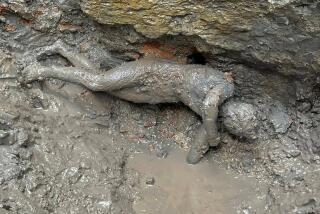Money Lacking to Preserve Glorious Ancient Ruins
- Share via
STAROSEL, Bulgaria — Gloom has replaced the rush of pride released by this summer’s find of the largest Thracian temple in the Balkans. Archeologists in a country rich in history but poor in cash are wondering who will pay for restoring the Bronze Age treasure.
With the estimated cost equaling this year’s total budget for maintaining historic monuments, the government cannot hope to come up with the funds. That’s bad news for the ruin, now exposed to weather damage--and for a country that could use all the tourist dollars it can get. Local and foreign tourists are already streaming in daily on the only winding dirt road to the site near Starosel, 81 miles east of Sofia.
Discoverers of the temple say it is of unparalleled importance in research into the Thracians, who lived in the Balkans between 4000 BC and the 7th century AD before being absorbed by invading Slavs.
Skills Were Advanced
Expedition chief Georgi Kitov calls it “the biggest discovery in 150 years of Thracian archeology,” saying the Starosel temple shows that the Thracians had unsuspected architectural, building and artistic skills.
“This may become a major tourist hub and, hence, a money-printing plant,” Kitov said. “This site vies with ancient Greek temples in Sparta, Athens and Micenaes.”
Archeologists started excavations in July after seeing treasure hunters digging in the area.
The temple is surrounded by a 263-yard-long stone wall. To the south it is crossed by a parade staircase flanked by two smaller staircases, climbing to an 11-yard roofless doorway with 5 1/2-yard-high walls leading to the facade.
The round stone wall symbolizes the sun, while the temple itself stands for the goddess of Earth, who lived in a cave, according to Thracians’ beliefs.
The interior consists of a rectangular entrance and a round vaulted main hall, whose ceiling is supported by 10 Doric semi-pillars, each carved with 10 vertical flutes. The inner walls are covered by ornate stone plates.
“One of the Thracians’ mightiest monarchs, probably Sytalcos, was buried in this temple,” Kitov said. referring to the 5th century ruler of the Odrises, a Thracian tribe, whose state existed in the southeast Balkans from the mid-5th century until the mid-4th century BC.
The temple is the centerpiece of a cult and burial site including several graves of high-ranking Thracian aristocrats and smaller sanctuaries hewn in surrounding rocks.
One of the graves revealed a Thracian warrior’s complete panoply, including a bronze helmet, kneepads, chain armor, a sword, bronze javelin tips, a quiver full of arrows, silver and ceramic utensils, a gold tiara and a 25-gram gold ring depicting a Thracian horseman piercing a wild boar.
Facing Cash Crunch
All in all, a monument clearly worth preserving--but there’s no cash for that, the government says.
“Our ministry’s budget for monuments of culture totals 500,000 leva [$217,000 U.S.] for this year, and there are 40,000 such monuments in Bulgaria,” Culture Ministry spokeswoman Yulia Krusashka said.
She said her ministry has asked the finance ministry for additional funding. But restoring and conserving the temple alone would cost $217,000 in American currency.
Even now, the 12 archeologists and 21 excavators at the site are struggling to make ends meet, despite the occasional private donation.
The archeologists are supposed to be paid 12 leva a day--or $5.20 U.S.--but they wait for months to receive the money because of overstretched state budgets.
They even lack film to photograph their finds.
More to Read
Sign up for Essential California
The most important California stories and recommendations in your inbox every morning.
You may occasionally receive promotional content from the Los Angeles Times.












